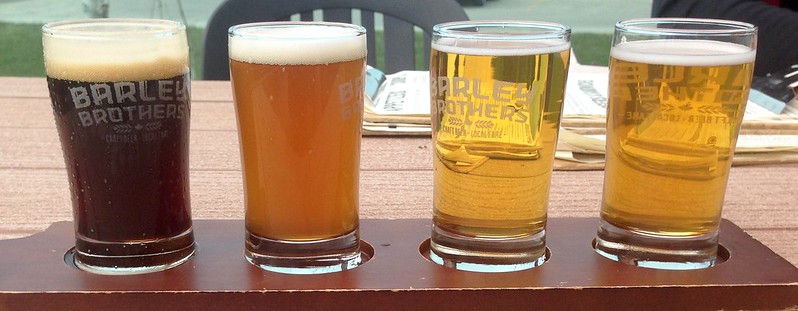Most of us typically aren’t thinking about the agricultural inputs that went into that beer we’re pouring at home or sipping at a restaurant, but without barley and hops the popular beverage wouldn’t exist as we know it today.
And brewers of all sizes understand the importance of maintaining and growing the specialty crops as the climate changes so they can continue to supply demand for the most-popular alcoholic beverage worldwide.
A report published in 2018 in the journal Nature Plants warned that climate change-related drought and heat would take a toll on the world’s barley supply, creating the potential for shortages and higher beer prices.
Beer is the most-consumed alcoholic beverage around the world, the report said, and demand for alcoholic drinks, as well as meat and dairy products, rises along with incomes, which means it’s likely there will be growing global demand for beer even as changing climate conditions challenge the world’s barley and hop supplies.
While drought is a key concern in some parts of the world, the opposite may be true in the US, where rainy conditions in the Midwest last year brought delays in planting and harvesting and, in some cases, caused a condition called preharvest sprouting that can make barley unsuitable for use in beer, according to the American Barley Malting Association.
In the US, changing climate and weather patterns have already fueled shifts in where the barley and hops needed to brew beer are grown, according to the Boulder, Colo.-based Brewers Association.
North Dakota used to be the top barley grower in the US, but conditions in that state have grown wetter and today Idaho now leads, said Chuck Skypeck, the Brewers Association’s technical brewing projects manager.
The American Malting Barley Association has been addressing climate change and its potential to affect barley crops as well. Barley crops do best with temperatures around 70 degrees, and temperatures hitting the mid-80s, especially at night, can take a toll on the crop.
Hotter temperatures also bring greater risk of pests and diseases, the group said in a news release.
Hop production has shifted as well. New York used to be the primary hop growing area in the US and it has since moved across the country to the dry side of the mountains in the Pacific Northwest, where long hours of daylight during the growing season give the crop what it needs, the Brewers Association’s Skypeck said.
While barley production has shifted, overall volumes have grown and, the 2018 report didn’t consider a key fact, Skypeck said. Researchers assumed barley crop yields would remain stable, when yields have actually been on the rise for quite some time and are continuing to grow as farmers and researchers develop new, hardier varieties.
“The yields have been increasing pretty substantially over the past several decades,” he said.
The Brewers Association, which represents craft brewers, has been focusing on sustainability challenges for several years. It created a sustainability group in 2013 to help its members achieve goals around water use and other resources.
In 2015 it began issuing grants to fund sustainability research, most of which have focused on agricultural issues in the areas of barley and hop cultivation. In the past five years, the group has issued more than $2 million in grants to fund more than 90 projects, including 13 that were funded for the 2020 fiscal year.
Brewers don’t buy barley directly from growers, they buy malt that’s made from the barley, and both hops and malt-grade barley are specialty crops that are largely or solely grown for beer brewing.
Barley quality is another key area of focus for researchers and farmers, because crops that fall short of malting quality drop considerably in value.
“It’s a risky crop for farmers to grow, because if it doesn’t make the quality grade, it’s worth a whole lot less,” Skypeck said.
If a crop doesn’t make the grade, farmers can sell it on secondary markets where it will go into products like livestock feed, but it will fetch a much lower price.
Terroir also comes into play – the geographic area where barley is grown will influence the flavor of the malt and the beer it’s used to make, Skypeck said, and some US brewers import malt from Europe to achieve richer flavored European-style beers.
The Brewers Association works with other groups including the American Malting Barley Association, the Hop Research Council and the Hop Growers of America on projects aimed at helping sustain and grow the key crops.
In addition to funding research under its own program, the Brewers Association also teamed with the US Department of Agriculture’s Agricultural Research Service in 2017 on a project to fund develop public sources of hop cultivars that are more resistant to pests and disease.
“In short, we aren’t just sitting back to see what happens next,” Skypeck said.
Related stories:
- 2020 Food forecasts focus on plants, sustainable food stories
- Agtech solutions allow farming to move indoors
- The rise of natural winemaking means more accidentally vegan vintages
_____________________________________
If you enjoyed this article, sign up for Restaurant Smartbrief to get news like this in your inbox, or check out all of SmartBrief’s food and travel newsletters as we offer more than 30 newsletters covering the food and travel industries from restaurants, food retail and food manufacturing to business travel, the airline and hotel industries and gaming.
